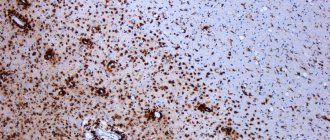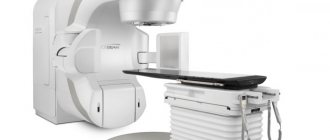Diagnostics
To determine multiple sclerosis, doctors use interviews and neurological examinations, and then confirm the diagnosis with MRI studies and tests.
MRI scans the brain and spinal cord for old and new lesions. For better visualization of fresh plaques, contrast is used. The diagnosis is made if the patient has 4 or more foci of demyelination measuring at least 3 mm, or 3 foci near the lateral ventricles, in the brain stem, cerebellum or spinal cord. In addition to MRI, the following may be prescribed for multiple sclerosis:
- regular blood tests to determine the level of immunoglobulins in the cerebrospinal fluid;
- lumbar punctures to study the composition of the spinal cord fluid.
How to stop multiple sclerosis: treatment of different forms of the disease
Unfortunately, despite progress in MS therapy, it is not yet possible to completely defeat the disease. However, if a person has multiple sclerosis, treatment can help reduce symptoms and reduce the number of relapses. Therapy is prescribed depending on the severity of the disease.
For progressive forms of MS, treatment can help reduce the severity of the disease. Specialists can prescribe:
- plasmapheresis - purification of the patient's blood;
- immunosuppressants - drugs that artificially suppress the immune system;
- immunomodulators are medications that regulate the body's immune response.
To prevent relapses, B-interferons can be used, and to reduce the intensity of symptoms, the following are used:
- vitamins E and B complexes;
- nootropics that improve brain activity;
- anticholinesterase drugs that inhibit the activity of the nervous system;
- muscle relaxants that help reduce muscle tone;
- enterosorbents that help remove toxins.
Multiple sclerosis: causes, stages, symptoms, diagnosis and treatment
Deterioration of vision is one of the most common symptoms of the disease, which can unexpectedly manifest itself in the following way: one eye will see well, and the other – poorly, flickering spots appear in front of the eyes, colors are distorted, there is a feeling as if something has got into the eye, blurry contours.
Discomfort in the limbs, which manifests itself in the form of goosebumps, burning, tightening of the skin, tingling. Very often we think that we just rested or rested our leg or arm, but if such symptoms appear regularly, we need to see a doctor.
Frequent urination, delays or inability to complete it, as well as sudden urges are also symptoms of multiple sclerosis (80% of patients have similar symptoms). That is why pay attention: if you drink your usual amount of liquid, but go to the toilet less often or more often, this is a reason to go to the hospital.
Loss of coordination is also a very common symptom, accompanied by loss of balance and strange, awkward sensations while walking. In this case, there may be pressure surges and diseases of the inner ear, so if such signs appear, you should not take them lightly. Sudden mood changes - from depression to fits of uncontrollable laughter, unexplained tears, depressive or suicidal thoughts that have no reason - are also symptoms of multiple sclerosis in both men and women. If you don't respond to them, depression can go far enough that it will be very difficult to cope with it. Speech becomes quiet and slurred, its pace slows down, the timbre changes (hoarseness or harshness may appear), and difficulties with swallowing also arise, since food and liquid may enter the trachea instead of the esophagus.
Almost all people with symptoms of multiple sclerosis note the presence of tremor, that is, trembling of the limbs, which appears due to damage to the nerve pathways that are responsible for the coordination of movements. This factor makes a person’s life very difficult, since simple functions such as holding a spoon, buttoning clothes, dialing a phone number, etc. become almost impossible. Sensitivity in the fingertips is lost, and they seem to go numb; it can be very difficult to understand whether hot or cold water flows from the tap, that is, the sensations are the same at ten degrees below zero and at sixty degrees below zero. This symptom is particularly serious, so if it is present, you should immediately consult a doctor.
Many people who have multiple sclerosis notice unpleasant sensations in their body - they feel like electric shocks. They can be observed when turning the head and respond in different parts of the body: legs, arms, back, etc.
If you notice any of the listed symptoms, this does not mean that you have multiple sclerosis, but if the symptoms recur, you should definitely consult a doctor.
Rehabilitation for multiple sclerosis
- Physiotherapy.
Exercise therapy helps improve a person’s condition with impaired motor activity. Working out on exercise machines helps restore coordination of movements. With correctly selected loads, the method demonstrated excellent efficiency. - Physiotherapy.
For patients with MS, electrophoresis, myostimulation, ultrasound, and magnetic therapy are recommended. These techniques help to activate the body's metabolic processes and reduce inflammation. - Massage.
For multiple sclerosis, this rehabilitation method can be used to relieve pain symptoms and spasms. Massage also helps improve muscle tone when it decreases.
Rehabilitation for multiple sclerosis also includes psychotherapy, which will help the patient cope with negative thoughts, as well as consultations with a nutritionist.
Disease prognosis
Multiple sclerosis is not considered a fatal disease; the unpleasant symptoms of MS can be quite successfully treated. Scientists have found that thanks to modern treatment, the life expectancy of patients today has increased significantly compared to those who fell ill even a few decades ago.
Overall, people with multiple sclerosis live on average 7 years less than the general population. Often, a decrease in life expectancy is associated with complications of other pathologies: cancer and cardiovascular diseases. For many patients, quality treatment can prevent a decline in quality of life and productivity. According to the National Multiple Sclerosis Society, ⅔ of people with MS are wheelchair-free even 20 years after diagnosis.
Disability in multiple sclerosis
| If multiple sclerosis has caused disability for 5 months or more within a year, the patient can apply for disability registration. |
After reviewing the documents, the commission will make a decision on incapacity for work, which gives the right to receive a pension and preferential working conditions. The establishment of a disability group is influenced by:
- the period for which the ability to work was lost;
- the period when the patient was registered with this disease;
- frequency, duration and severity of exacerbations;
- therapy results;
- changes in the course of the disease, the rate of development of symptoms.
Disability is assigned for a year, after which it is necessary to pass the commission again. Disability of groups I and II with MS gives the right to a reduced working day - 35 hours per week. In this case, wages are paid in full.
Belarus is in a high-risk zone for the incidence of multiple sclerosis - more than 50 cases per 100 thousand people are registered in the country.
- in 2016, 51.9 cases per 100 thousand population were registered;
- in 2017 - 54.9 per 100 thousand;
- in 2018 - 56.7 per 100 thousand.
Experts attribute this prevalence to the geographical location of the country (there is an opinion that the further the country is from the equator, the higher the incidence), with a lack of sunlight and vitamin D. There are many factors that influence the likelihood of developing multiple sclerosis. Heredity plays a role. In addition, an increase in the number of cases may be associated with improved diagnosis of the disease.
Multiple sclerosis (MS) is a chronic, progressive autoimmune disease in which a person's own immune cells destroy the myelin sheath of nerve fibers. As a result, the speed of nerve impulse transmission and, accordingly, the function of the muscle fiber decreases. As the disease progresses, aggressive immune cells not only damage the myelin sheath of neurons, but also lead to the death of nerve cells.
Ekaterina Mazurenko, Associate Professor of the Department of Neurology and Neurosurgery of BelMAPO, Candidate of Medical Sciences. Science Ekaterina Mazurenko:
“Approaches to diagnosing the disease have changed. Previously, after the first clinical episode, the patient was given an amorphous diagnosis of “demyelinating disease of the central nervous system,” which did not allow timely administration of adequate therapy for multiple sclerosis. The modern approach involves early detection of the disease and the prescription of preventive treatment, which allows our patients to remain active and able to work for a long time. Today, a new term “clinically isolated syndrome” is used to denote the first clinical attack of the disease. In some cases, after the first clinical episode and in the presence of changes on MRI of the brain that are typical for multiple sclerosis, we can prescribe preventive treatment.”
The modern classification of multiple sclerosis is based on the type of disease, since it is these differences that determine the treatment tactics for patients.
Three types of multiple sclerosis
- relapsing-remitting MS;
- secondary progressive type of MS;
- primary progressive type of MS.
Relapsing- remitting MS. Exacerbations with the appearance of new clinical symptoms alternate with remissions. There is a complete or partial restoration of functions after an exacerbation. The cardinal feature is the absence of an increase in symptoms during periods of remission. Over time, in more than half of patients, this type of course transforms into secondary progressive MS.
Secondary progressive type of MS (SPMS). It usually develops 5–10 years from the onset of the disease. The deterioration of the patient's condition is associated with an increase in clinical symptoms during periods of remission, which is the main diagnostic sign of this form. In some cases, there is a slow progression of the disease without periods of improvement and exacerbations, in others, exacerbations persist, but become more erased against the background of a steady slow deterioration of neurological symptoms.
Primary progressive type of MS. From the moment of the first episode of the disease, there is a gradual, steady increase in neurological symptoms for at least 1 year, without clear periods of exacerbation and remission.
Ekaterina Mazurenko:
“Multiple sclerosis is always two parts: inflammation and neurodegeneration. Inflammation is characterized by the appearance of new clinical symptoms and the formation of active foci of demyelination on MRI. Neurodegeneration is observed already in the earliest stages of the disease and is manifested by damage to neuron axons and brain atrophy. When axonal damage accumulates in any functional system, the patient experiences irreversible disability. That is why early detection of the disease, adequate treatment of exacerbations and timely administration of preventive treatment are so important, which helps to avoid an increase in severe physical limitations and disability in the patient.”
In what cases should a patient be referred to a neurologist?
To a general practitioner (therapist):
The patient complains of the appearance of symptoms in various functional areas. For example, unsteadiness and uncertainty when walking, awkwardness or weakness of one or both arms, legs, transient tingling and numbness of the limbs, double vision, difficulty swallowing. Quite characteristic of the initial stages of the disease is the periodic appearance and disappearance of symptoms. In any case when a patient develops neurological symptoms, the general practitioner should refer the patient to a neurologist.
To the ophthalmologist:
The patient complains of significant blurred vision, double vision, or the appearance of a “blurry spot” before the eyes. If a diagnosis of “retrobulbar neuritis” is made, especially in young people, such a patient should definitely be referred for a consultation with a neurologist.
To the urologist:
Multiple sclerosis may begin with urological problems (urinary urgency or incontinence, urinary retention).
Diagnosis of multiple sclerosis
Multiple sclerosis is characterized by a variety of symptoms affecting various functional systems.
The visual sphere is affected: there is a decrease in vision, which is not corrected by glasses, patients may complain of pain behind the eye, and visual fields fall out. Over time, vision may be restored partially or completely.
Sometimes the disease can debut with damage to the pyramidal system: the patient experiences a decrease in muscle strength, changes in the reflex sphere (decreased skin reflexes, increased tendon-periosteal reflexes, as well as the appearance of pathological signs).
The coordination system may be affected : walking and coordination of movements are impaired.
may be affected : Patients with MS experience limb numbness and paresthesia.
Brainstem symptoms often : blurred speech (dysarthria) or impaired swallowing, choking when eating (dysphagia), impaired conjugal eye movements (internuclear ophthalmoplegia).
Currently, diagnosis of the disease is carried out according to the 2021 Macdonald criteria , which are used throughout the world. Their goal is to simplify and speed up diagnosis.
Main diagnostic criteria:
- the presence of clinical manifestations (at least two clinical attacks and damage to two systems) according to the patient’s neurological status;
- the presence of characteristic foci of demyelination according to the results of magnetic resonance imaging of the brain and/or spinal cord.
Features of the course and diagnosis of secondary progressive multiple sclerosis
The secondary progressive type of MS (SPMS) is characterized by the predominance of the neurodegenerative process over the inflammatory process, which means that the patient will experience increased brain atrophy, axonal damage and associated disability.
Ekaterina Mazurenko:
“The majority of patients are with the relapsing-remitting type of multiple sclerosis. Unfortunately, over time they develop a secondary progressive form. The risk of transition varies and depends on a number of factors. Time plays a role: the longer the patient is sick, the higher the likelihood. This development of events may be influenced by inadequate treatment of exacerbations. It is very important to remove them in time with pulse therapy using hormones (methylprednisolone). An internationally recognized regimen: 1000 mg intravenously daily for 3–5 days. Adequate treatment of exacerbations allows you to quickly relieve inflammation and prevent axonal degeneration, and therefore avoid the accumulation of residual neurological deficits in the patient.”
The key point in the course and diagnosis of the secondary progressive type of multiple sclerosis is the increase in neurological symptoms in the period between exacerbations. The main criterion for progression is the increase in EDSS score over 6 months. The EDSS scale allows you to very clearly and effectively assess the degree of disability of the patient and track the deterioration of the neurological status.
Unfortunately, the secondary progressive type of MS is difficult to treat. This is due, among other things, to the fact that most drugs that modify the course of multiple sclerosis affect inflammation, while in SPMS neurodegenerative processes predominate. However, drugs for the treatment of SPMS have already been registered around the world.
Why is it so important to get a diagnosis early?
The later treatment is prescribed, the sooner the patient will reach an EDSS score of 6 (which means he has become disabled). Therapy is considered most effective when assessed on the EDSS scale from 0 to 3 points. It is important to make a timely diagnosis and prescribe preventive treatment to reduce the frequency and severity of exacerbations and make the course of multiple sclerosis manageable.
The route of a patient with multiple sclerosis
If multiple sclerosis is suspected, to confirm the diagnosis and decide whether to prescribe DMT, the neurologist issues a referral:
Minsk and Minsk region:
- Minsk City Consultative and Diagnostic Center (it is the main institution);
- 5 city clinical hospital;
- Minsk Scientific and Practical Center for Surgery, Transplantology and Hematology (formerly 9th City Clinical Hospital);
- Republican Scientific and Practical Center of Neurology and Neurosurgery;
- Minsk Regional Clinical Hospital.
Brest:
- Brest Regional Clinical Hospital.
Vitebsk:
- Vitebsk Regional Diagnostic Center;
- Vitebsk Regional Clinical Hospital;
- Vitebsk Regional Clinical Specialized Center.
Gomel
- Gomel Regional Clinical Hospital.
Grodno
- Grodno University Clinic.
Mogilev
- Mogilev Regional Clinical Hospital.
The appointment of PMTRS is determined by a medical council consisting of the chief freelance neurologist of the region, the head of the department, the attending physician, and an employee of the department of neurology of educational institutions. According to the order of the Ministry of Health dated February 20, 2020 No. 174, which regulates the prescription of DMT, treatment of multiple sclerosis begins from the moment the first episode appears, if there are foci of demyelination in the brain and/or spinal cord on MRI.
Ekaterina Mazurenko:
“When choosing a drug that modifies the course of multiple sclerosis, the risk and benefit for the patient are assessed in each individual case. It takes into account how aggressive the disease is and how often exacerbations are recorded.”
The effectiveness of treatment is assessed using three main indicators:
- presence of clinical manifestations;
- appearance of new lesions on MRI;
- increase in disability according to the EDSS scale.
Performing MRI with contrast allows you to assess the activity of the pathological process. This test identifies areas of demyelination in the brain and/or spinal cord that have a number of typical features. It will help identify acute foci of demyelination (they accumulate contrast) that have appeared relatively recently, for example, within a few weeks. In general, MRI evaluates both the appearance of new lesions and the increase in the size of old ones.
Additional training on MS
The BelMAPO website has a training module dedicated to the diagnosis of multiple sclerosis, which includes the main criteria for diagnosing the disease and detailed instructions for using the EDSS scale. In addition, in advanced training courses, part of the lectures are also devoted to the problem of MS.
This information is intended for medical and pharmaceutical professionals only. To be distributed at the venues of medical or pharmaceutical exhibitions, seminars, conferences and other similar events or directly transferred to medical and pharmaceutical workers. Dissemination of information by any other means that opens access to it to an indefinite number of persons is prohibited. The images used are not of actual patients. The article was created with the support of Novartis Pharma Services AG (Switzerland), representative office in the Republic of Belarus. BY/NEUR/11.2020/pdf/102662











